The Samsung 970 EVO Plus (250GB, 1TB) NVMe SSD Review: 92-Layer 3D NAND
by Billy Tallis on January 22, 2019 10:00 AM ESTRandom Read Performance
Our first test of random read performance uses very short bursts of operations issued one at a time with no queuing. The drives are given enough idle time between bursts to yield an overall duty cycle of 20%, so thermal throttling is impossible. Each burst consists of a total of 32MB of 4kB random reads, from a 16GB span of the disk. The total data read is 1GB.
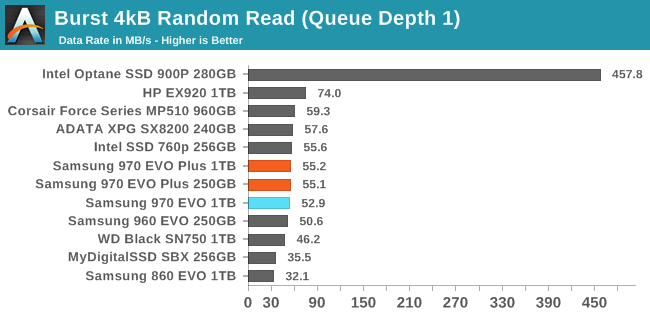
The QD1 burst random read performance of the Samsung 970 EVO Plus is an improvement over its predecessor, but not as large as was promised by the spec sheet. The Samsung drives are also still lagging far behind the fastest combinations of IMFT NAND and Silicon Motion controllers.
Our sustained random read performance is similar to the random read test from our 2015 test suite: queue depths from 1 to 32 are tested, and the average performance and power efficiency across QD1, QD2 and QD4 are reported as the primary scores. Each queue depth is tested for one minute or 32GB of data transferred, whichever is shorter. After each queue depth is tested, the drive is given up to one minute to cool off so that the higher queue depths are unlikely to be affected by accumulated heat build-up. The individual read operations are again 4kB, and cover a 64GB span of the drive.
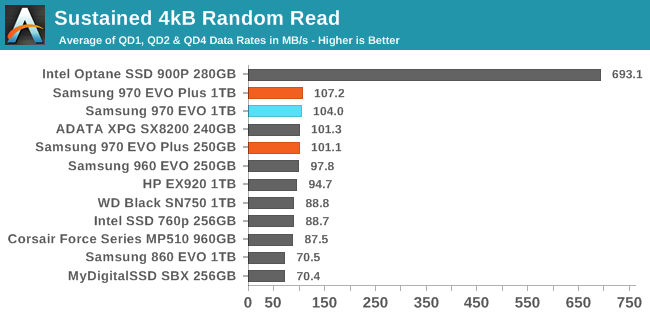
On the longer test of random read performance that also brings in some higher queue depths, the Samsung 970 EVO Plus is more competitive and comes out tied or ahead of last year's best. But not shown here are the preliminary results from our tests of SM2262EN drives (next in the review queue) which are substantially faster than the 970 EVO Plus.
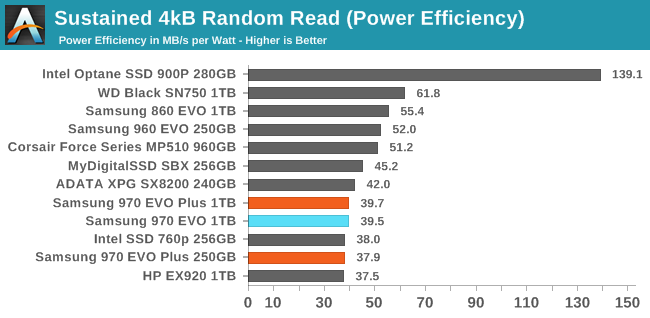 |
|||||||||
| Power Efficiency in MB/s/W | Average Power in W | ||||||||
The 970 EVO Plus uses more power during the random read test than any other drives in this bunch, leaving it with some of the worse efficiency scores despite the good performance.
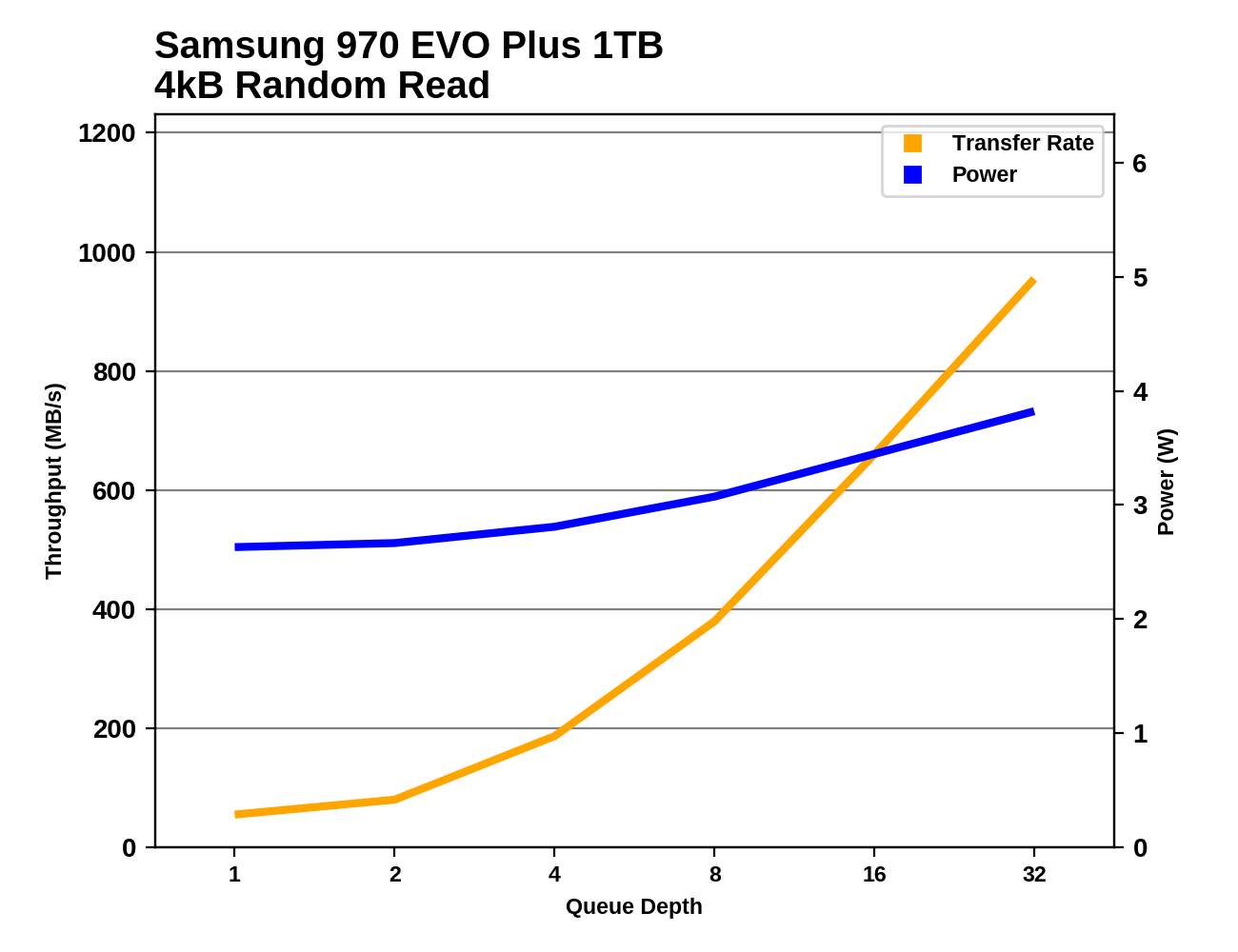 |
|||||||||
The random read performance of the 250GB 970 EVO Plus begins to fall behind the 1TB model as queue depths increase, and the smaller drive seems to be close to saturating by QD16. At QD32 the 250GB model's random read throughput is less than half that of the 1TB model. The 250GB 960 EVO delivered substantially higher random read performance at high queue depths than the small 970 EVO Plus manages.
The relatively high power consumption of the 970 EVO Plus is apparent when plotting its test results against the rest of the database. At lower queue depths it delivers speeds that are achievable by SATA SSDs but uses more power than almost all of them. Once the queue depth has increased sufficiently to take the 970 EVO Plus beyond the SATA limit, it still uses more power than most of the remaining competition.
Random Write Performance
Our test of random write burst performance is structured similarly to the random read burst test, but each burst is only 4MB and the total test length is 128MB. The 4kB random write operations are distributed over a 16GB span of the drive, and the operations are issued one at a time with no queuing.
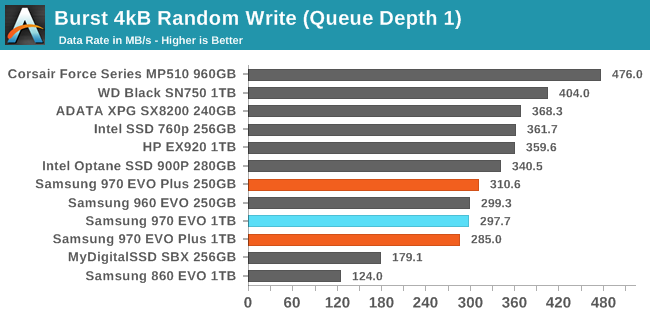
The burst random write performance of the 970 EVO Plus takes a slight step backwards from its predecessor, leaving it far behind the best competitors, which are currently led by the Phison E12-based Corsair MP510, 67% faster than the 970 EVO Plus.
As with the sustained random read test, our sustained 4kB random write test runs for up to one minute or 32GB per queue depth, covering a 64GB span of the drive and giving the drive up to 1 minute of idle time between queue depths to allow for write caches to be flushed and for the drive to cool down.
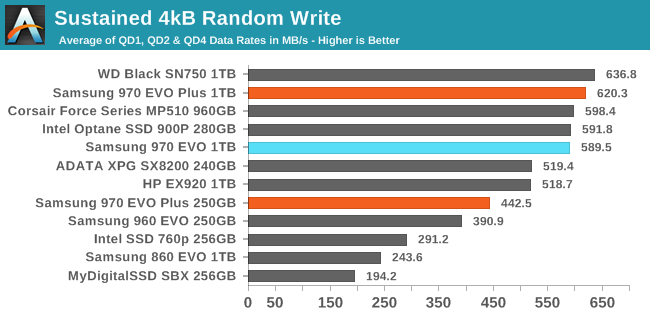
When the longer random write test brings in some higher queue depths, the 1TB 970 EVO Plus regains a high-end standing but doesn't quite catch up to the WD Black SN750. The 250GB model is a bit further behind the lead thanks to the fast write cache of the ADATA SX8200, which performs identically to that of the related 1TB HP EX920.
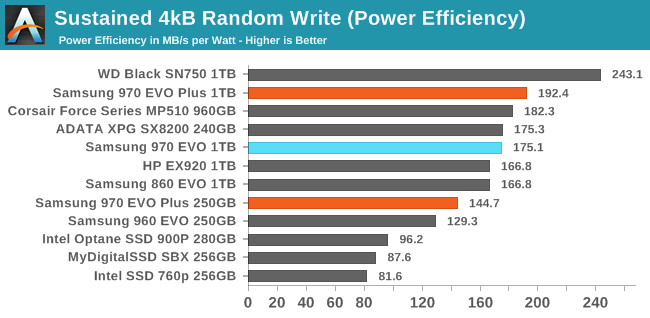 |
|||||||||
| Power Efficiency in MB/s/W | Average Power in W | ||||||||
The 970 EVO Plus improves upon the random write power efficiency of its predecessors and ranks very highly, but the WD Black SN750 provides 26% better performance per Watt on this test, and the ADATA SX8200 beats the 250GB 970 EVO Plus by 21%.
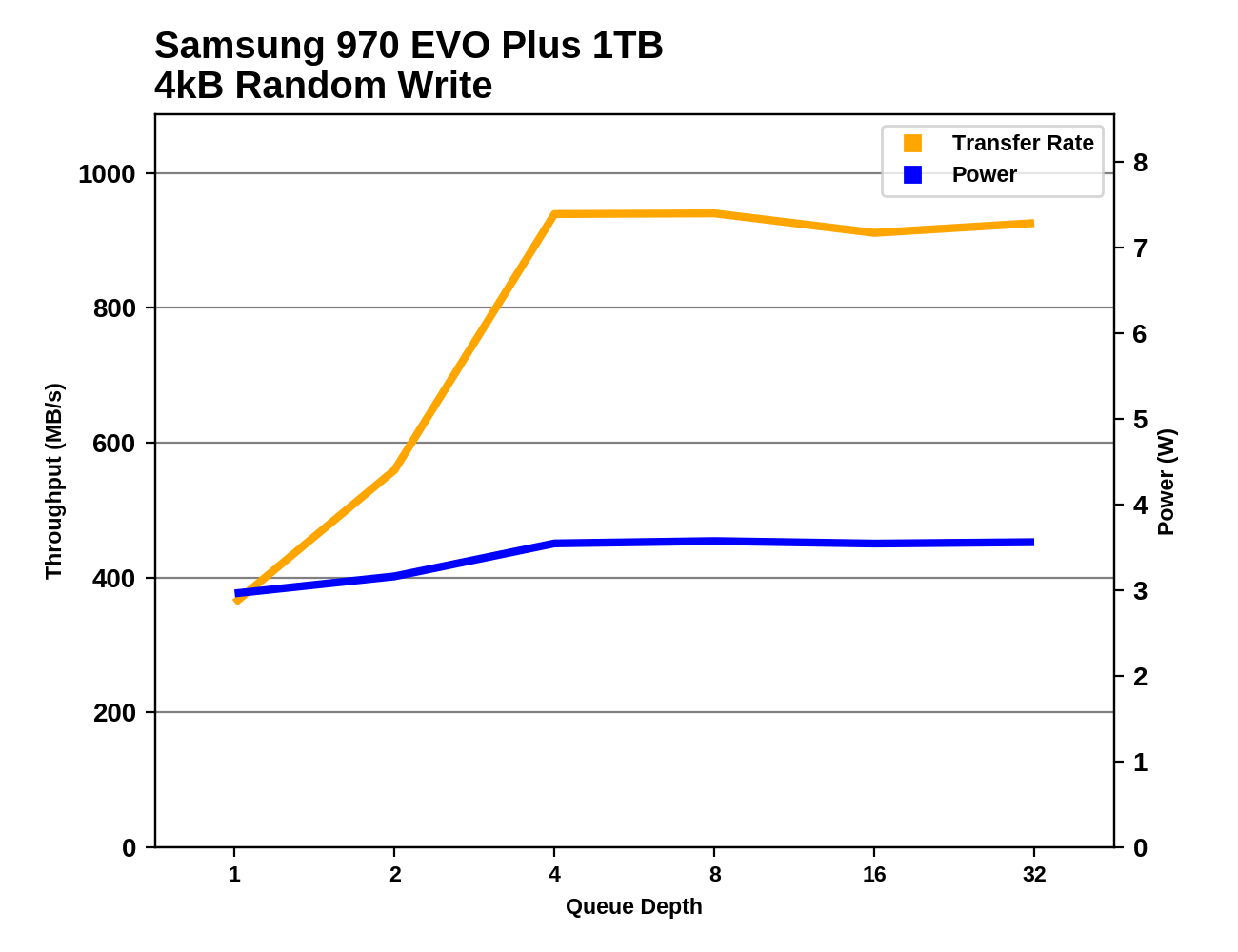 |
|||||||||
The Samsung 970 EVO Plus reaches full random write speed by QD4 and is reasonably steady through the rest of the test. The 1TB model saturates at a slightly higher level than the WD Black SN750, but its overall score suffered due to the slower QD1 performance. The ADATA SX8200 that provides excellent low-QD random write performance at low capacities does run out of SLC cache for part of the test and drops below the 250GB 970 EVO Plus's performance level for a while before recovering.
Comparing the 970 EVO Plus against all the results in the database shows the 1TB drive starts out with QD1 performance just beyond the limit for SATA drives, and power requirements don't increase much as throughput climbs. At higher queue depths the 970 EVO Plus falls roughly in the middle of the normal power consumption range for high-end drives.


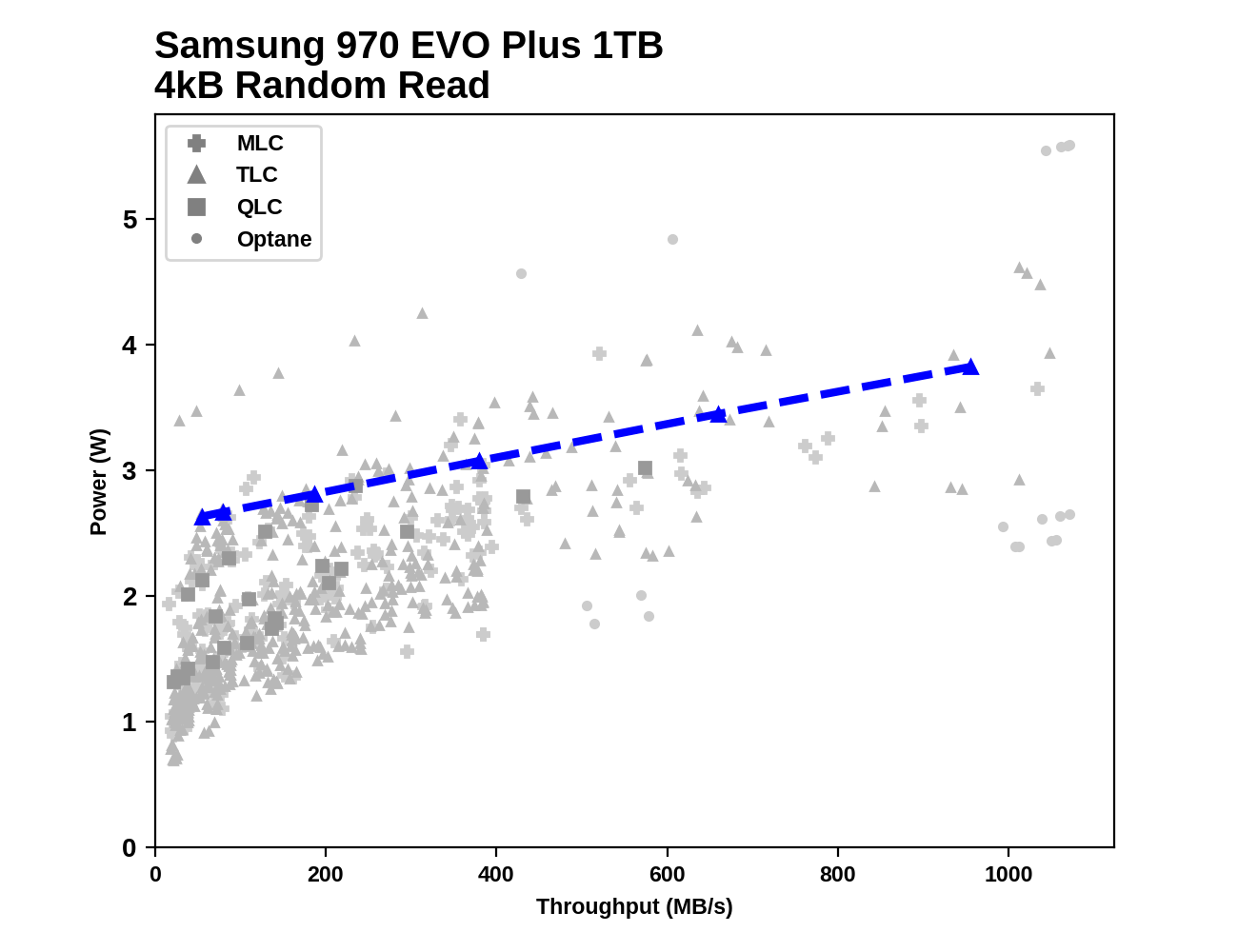
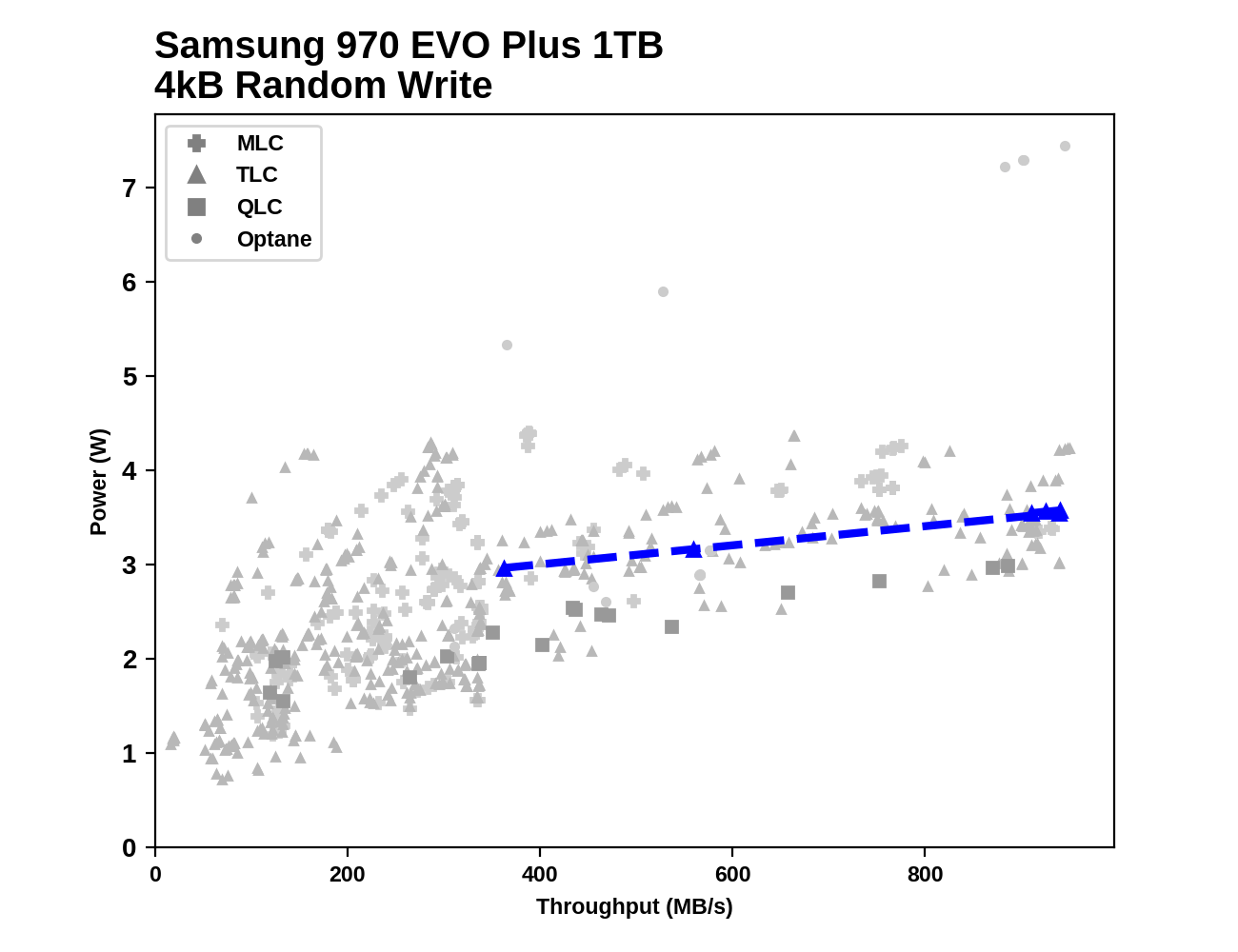








35 Comments
View All Comments
jaydee - Wednesday, January 23, 2019 - link
HP EX920 is still the best price/performance option by comfortable margin.kidfromthe90s - Thursday, January 24, 2019 - link
Barely noticeable in real life... unless you're doing massive FEA simulations like CFDsNotationMaster - Monday, March 11, 2019 - link
Which enclosure would you suggest for such a drive to use with a T3 equipped (USB-C only) MacBook Pro? Thank youstar-affinity - Thursday, March 21, 2019 - link
This:https://raidsonic.de/products/external_cases/exter...
Or this:
https://raidsonic.de/products/external_cases/exter...
Still they are just USB-C which means maximum 10 Gb/s transfer which will limit a NVMe drive such as the 970 EVO Plus quite a lot.
Haven't really found and any compact external M.2 enclosures that are bus powered over Thunderbolt 3. Maybe they exist? But there's this: https://vimeo.com/303171402
Margaronis - Thursday, April 11, 2019 - link
A good external tb3 case is the TEKQ Rapide. Recently reviewed on anandtech. One thing though, be aware that the samsung 970 evo plus in that case (or possibly any external case) does not play nice with MacOS. It’s a firmware issue, the non plus version is apparently fine, so TEKQ tell me as I’ve just fallen down that hole